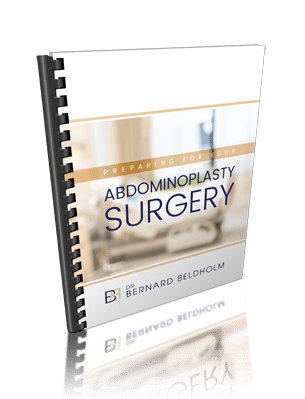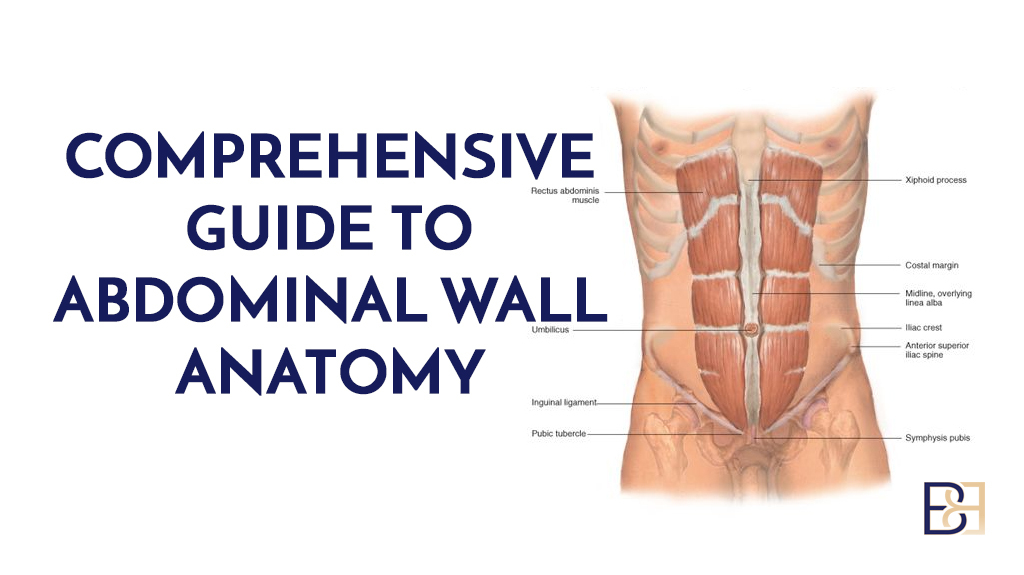Self-assessment measures, such as evaluating physical condition, defining Fleur-de-lis (FDL) goals, assessing skin laxity extent, and determining discomfort or dysfunction can help a patient determine if they are the ideal FDL candidates.
More extensive and complex than standard abdominoplasty, Fleur-de-lis (FDL) abdominoplasty is the ideal option for anyone with skin laxity on the abdominal area that cannot be effectively treated with a traditional abdominoplasty procedure. However, it can be challenging for patients to determine whether they are ideal candidates for an FDL procedure on their own, which is why I highly suggest that you come in for a consultation. Until then, however, patients can conduct a self-assessment to determine if they fit the Fleur-de-lis profile.

Book your appointment online now
To get you started, we’ve put together these tips to help you perform self-testing for FDL abdominoplasty at home.
Self-Assessment Steps
The ideal and recommended way for any patient to determine if they’re the ideal FDL candidate is to contact a FRACS surgeon. Dr. Bernard Beldholm engages his patients in a 45-minute consultative session, during which he makes a comprehensive assessment and gives recommendations based on his over 15 years of experience.
However, before a patient books a consultation with a certified plastic surgeon, they can conduct a self-assessment to determine if they fit the Fleur-de-lis patient profile.
Step 1: Determine the Cause of Loose Skin and Excess Fat
It is important to first determine the cause of skin laxity in the upper and lower abdomen. Dr. Bernard Beldholm recommends considering a Fleur-de-lis operation for patients who have experienced significant weight loss, typically in excess of 20kg.
Fleur-de-lis is never a weight loss option. It is a post-weight loss surgery ideal for loose skin and excess fat after significant weight loss and pregnancy. FDL also repairs stretched and damaged abdominal muscles caused by the expansion of the uterus during pregnancy.
Significant weight loss is when a patient sheds the equivalent of over five per cent of their total body weight.
Step 2: Maintain Stable Weight
After the patient confirms that the skin laxity was due to significant weight loss, the next question is: How long have they maintained their weight?
Dr. Beldholm recommends maintaining a stable weight for six to twelve months. During this period, the patent should not have recorded significant weight fluctuations.
Step 3: Smoking
Smokers have a greater risk of developing post-op complications that might escalate and become severe. Smoking hinders blood flow to the affected tissues and skin, delaying healing. The longer the Fleur-de-lis incision wound takes to heal, the higher the chances of developing complications.
A study by the National Library of Medicine shows that “[s]moking has a negative impact on skin health. Numerous studies have effectively linked smoking with delayed wound healing and healing complications. Research has identified cigarette smoking affects wound healing at a cellular level. Reducing fibroblast activity and keratinocyte migration.”
Therefore, smokers are advised to quit smoking for at least six weeks before and after surgery.
Step 4: Any Plans to Get Pregnant in the Future?
Mothers considering Fleur-de-lis should determine if they plan on getting pregnant. If not, they should proceed and book a consultation with Dr Bernard Beldholm.
Fleur-de-lis is a major surgery, and the body needs enough time to heal. Getting pregnant before the specified period creates excess abdominal stress, undoing tightening skin, and other Fleur-de-lis cosmetic results.
Furthermore, the vertical and horizontal incisions leave a more pronounced scar because of the procedure’s invasiveness.
Evaluating Your Physical Condition and Goals
If a patient qualifies for the above criteria, the next step is to consider their condition, goals, and expectations. This information is crucial in helping the FRACS surgeon determine the ideal procedures and make recommendations so that the patient can make informed decisions. Here’s the recommended way for patients to assess their goals and expectations:
Excess Skin and Fat Evaluation
How much loose skin and fat does the patient want removed? Is the skin laxity in the horizontal as well as vertical direction?
When there is a significant amount of weight loss, loose skin can occur both horizontally and vertically. When you carry excess weight, your skin is stretched like a balloon. When you lose the weight, the skin becomes loose in all directions.”
Horizontal Excess Skin

Excess skin and fat that is located on the sides of the abdomen is known as horizontal excess. The only way to correct this is by excising the skin in the middle through a vertical incision and bringing the skin towards the midline. This is done though a fleur de lis abdominoplasty.
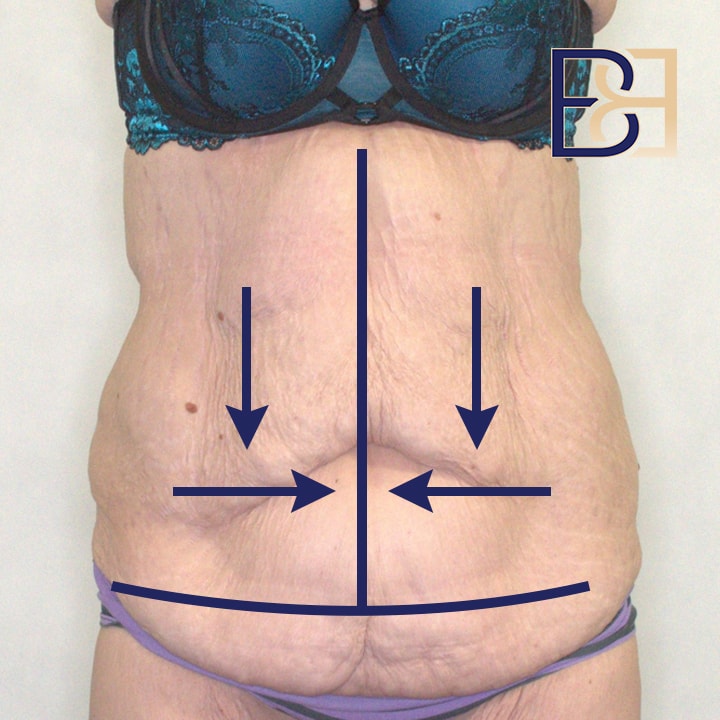
Vertical Excess of Skin in the Abdomen
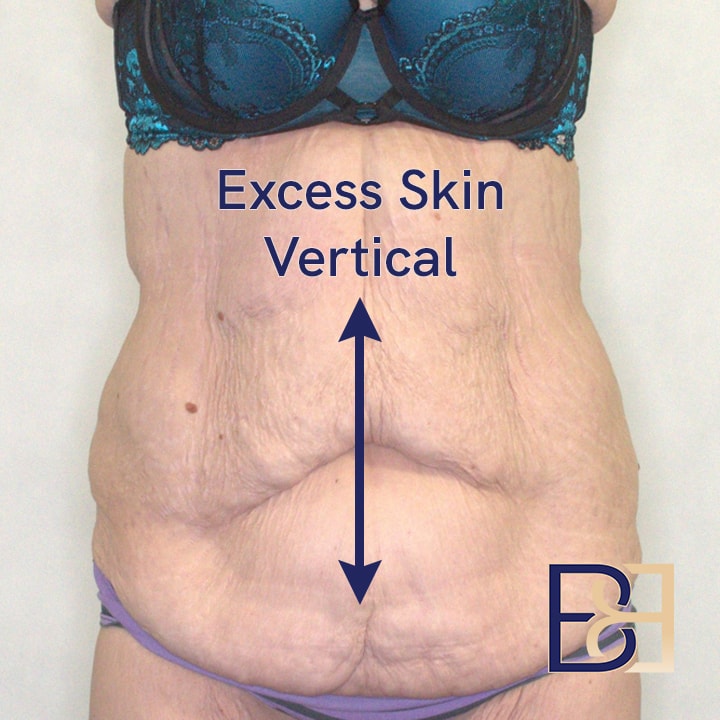
Vertical excess in the abdominal area refers to the surplus skin stretching from the upper to the lower abdomen. This excess skin is often the result of significant weight loss, aging, or post-pregnancy changes. It can create what is commonly known as the “apron” effect or overhang, where the skin drapes over the lower abdominal region, sometimes exacerbating discomfort and contributing to hygiene challenges. In individuals with previous C-section surgeries, the overhanging tissue can sag more prominently just above the surgical scar, leading to the characteristic skin fold. Managing vertical excess may involve surgical interventions, like abdominoplasty, to remove the redundant skin.
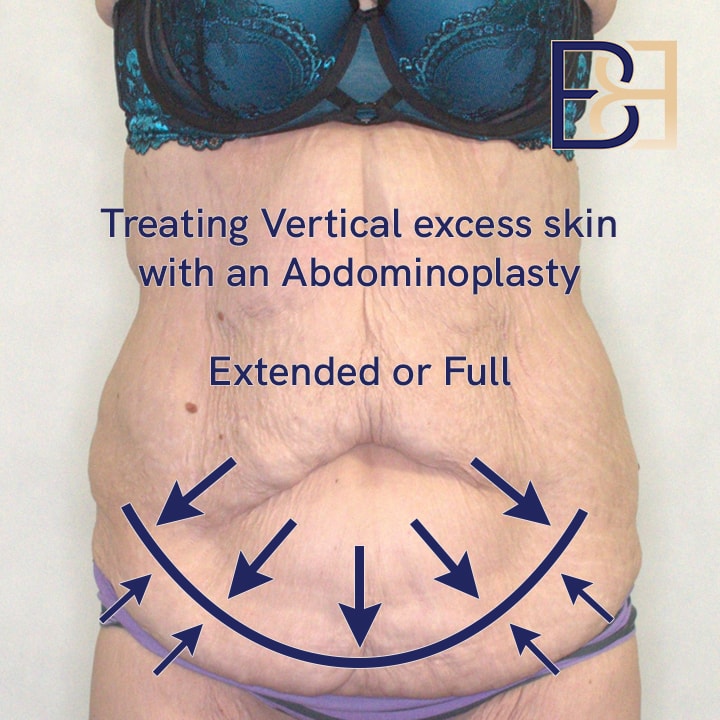
When there is excess horizontal and vertical skin, a fleur de lis abdominoplasty is often recommended. Unlike the traditional abdominoplasty, the fleur de lis approach involves an additional vertical incision, which allows for the removal of excess tissue in a more extensive manner. This technique enables surgeons to contour the abdomen more effectively, providing a more comprehensive treatment for individuals seeking a firmer and more toned abdominal appearance. While the fleur de lis abdominoplasty offers superior aesthetic outcomes, it does involve significant incisions.
Previous Weight Loss
Dr. Bernard Beldholm recommends an FDL after significant weight loss.
Massive Weight Loss is when an adult patient loses over 5% of their total body weight in 6 to 12 months or over 20 kilograms in the same period. A National Library of Medicine study shows that, “[c]linically significant weight loss (CWL) is defined as at least a 5% reduction in weight from the baseline level, and associated with ** in cardiometabolic risk factors, such as beneficial changes in lipid profile and insulin sensitivity.”
It is also essential to determine the cause of weight loss. For instance, a patient who undergoes massive weight loss due to an underlying medical condition might not be an ideal Fleur-de-lis candidate.
Skin Laxity and Stretch Marks
The best starting point for patients when determining their expectations is to identify the amount of loose skin they have and would like removed. Having an idea of the amount of excess they wish removed makes it easier for the FRACS surgeon to recommend relevant and effective surgical procedures. For instance, if a patient wants to remove more abdominal fat, the specialist surgeon will include suction-assisted lipectomy (liposuction.)
Other factors, such as the presence and severity of stretch marks, should be taken into consideration when defining expectations. The good news is that Dr Beldholm incorporates practical and effective supplementary surgical techniques to treat such issues.
Body Shape and Contour Goals
An FDL procedure alters a patient’s abdominal appearance. Therefore, the patient should have an idea of how they wish their body contour to look after their procedure. This makes it easier to determine the extent of loose skin and excess fat to be removed.
However, it is crucial to set realistic goals. The best way to do this is to seek professional and expert advice.
Dr. Beldholm takes a better approach to helping his patients set realistic body shape and youthful appearance goals. During the consultative session, he uses before-and-after photos of his previous clients. These images also help the patients assess the effectiveness of the recommended surgical procedure.
Physical Discomfort or Dysfunction
For some patients, Fleur-de-lis abdominoplasty might be medically necessary. A medically necessary situation is any condition that hinders and affects the normal functioning of a person’s body. Only surgeons and certified healthcare specialists can determine whether a condition is deemed medically necessary.
The condition might be medically necessary if significant skin laxity threatens the patient’s health, causes irritations, or harbours infections. Australian residents qualify for a rebate when a surgeon proves the condition is medically required.
A certified surgeon guides their patients through getting a rebate and explaining what costs are covered. Dr Bernard Beldholm explains to his clients the respective MBS item number for which their procedure qualifies and the covered costs. These rebates can significantly reduce the out-of-pocket cost of their Fleur-de-lis surgery.
Previous Surgeries
Patients who’ve undergone any surgery should wait between six to twelve months before having another major procedure. This gives the body enough time to heal and the affected tissues time to recover. For instance, a woman who recently had a C-section during childbirth should consider waiting 12 months before undergoing FDL surgery.
Furthermore, patients must share their surgical history with their specialist surgeon when determining the ideal abdominal procedure. The surgeon may advise whether using the healed incision (scar) from a previous surgery is a feasible option.
Questions to Ask Yourself
Have I lost considerable weight, leading to excess skin that cannot be managed with diet and exercise alone?
If yes, an FDL procedure could be the remedy. Patients who’ve undergone significant weight loss through diet and exercising are unable to eliminate skin laxity with their respective weight-loss tactics. Therefore, a Fleur-de-lis is a body contouring measure to complement their weight loss efforts.
Am I prepared for a longer recovery period and a more extensive scar compared to traditional abdominoplasty?
A Fleur-de-lis is more invasive than a standard tummy tuck. It involves extensive vertical and horizontal incisions, which need more time to heal fully. Furthermore, the two incision lines result in a more extensive scar.
Next Steps
Patients who qualify for the self-assessment tests and the above criteria may be Fleur-de-lis candidates. Their next steps include;
Research Surgeons
This stage requires patients to take their time evaluating the available surgeons based on their locations, availability, and recommendations. Patients should choose highly qualified and experienced surgeons for optimal results. Some crucial information to ask the surgeon include;
- Academic and training qualifications
- Fleur-de-lis track record
- List of their previous patients
- Online reviews
- Research about their medical facility
- Medical history and surgical record
- Insurance coverage
Among other questions, the above will help patients narrow the extensive list to one or two surgeons.
Schedule a Consultation
Dr. Bernard Beldholm invites potential Fleur-de-lis patients to a 45-minute consultative session. During this interactive session, he urges patients to share their Fluer-de-lis goals and expectations. He also advises patients to bring their medical and surgical history documents, medication list, their insurance card, and relevant X-rays and tests.
Evaluation By a Specialist FRACS Surgeon For A Definitive Assessment
The FRACS surgeon then deeply assesses the patient’s medical history to confirm they are the ideal candidate for that procedure. Next, visual and physical assessments by the surgeon will determine the required amount of loose skin and excess fat to be removed to match the patient’s expectations.
Prepare for Surgery
After a successful consultative session, Dr. Beldholm preps his patients and books their Fleur-de-Lis procedure based on availability. A qualified FRACS surgeon takes full responsibility and guides their patient through the entire FDL process.

FAQs
How long does it take to recover from Fleur-de-Lis surgery?
Patients can expect to take three to six weeks to resume normal activities. Full recovery takes six to twelve months.
What are the potential Fleur-de-lis complications?
FDL procedures carry possible complications such as infection, bleeding, temporary redness, pain, seroma, and swelling. However, getting a qualified and experienced FRACS surgeon reduces these risks.
How painful is a Fleur-de-lis?
Patients can expect moderate pain levels after their Fleur-de-lis procedure. Dr Beldholm prescribes pain medication that helps his patients manage their discomfort.

Final Thoughts
A Fleur-de-lis procedure is the ideal option for patients with significant upper arms and lower abdomen skin laxity. The above self-assessment tips are practical for any potential FDL patients, including new participants. Dr. Bernard Beldholm, a qualified, experienced, and certified FRACS surgeon, invites potential patients to book a consultative session to begin their surgery.
Book your appointment online now
Resources
- McRobert J. (2013). Smoking and its effects on the healing process of chronic wounds. British journal of community nursing, Suppl, S18–S23.
- Swift, D. L., Johannsen, N. M., Lavie, C. J., Earnest, C. P., Blair, S. N., & Church, T. S. (2016). Effects of clinically significant weight loss with exercise training on insulin resistance and cardiometabolic adaptations. Obesity (Silver Spring, Md.), 24(4), 812–819.
- Mitchell, R. T., & Rubin, J. P. (2014). The Fleur-De-Lis abdominoplasty. Clinics in plastic surgery, 41(4), 673–680.
- Dellon A. L. (1985). Fleur-de-lis abdominoplasty. Aesthetic plastic surgery, 9(1), 27–32.
- Dellon A. L. (1985). Fleur-de-lis abdominoplasty. Aesthetic plastic surgery, 9(1), 27–32.
- Friedman, T., O’Brien Coon, D., Michaels V, J., Purnell, C., Hur, S., Harris, D. N., & Rubin, J. P. (2010). Fleur-de-Lis abdominoplasty: a safe alternative to traditional abdominoplasty for the massive weight loss patient. Plastic and reconstructive surgery, 125(5), 1525–1535.
- DeSerres, J. J., Quaife, T., Morzycki, A., Curran, M. W. T., & Toy, J. (2021). Safety of Fleur-de-lis Abdominoplasty after Massive Weight Loss. Journal of plastic, reconstructive & aesthetic surgery : JPRAS, 74(1), 223–243.
- Mendes, F. H., Viterbo, F., & Moragas, W. R. (2024). Finesse in Fleur-de-lis Abdominoplasty. Clinics in plastic surgery, 51(1), 81–93.
- Savva, D., Nittari, G., Gibelli, F., & Vassiliou, A. (2022). Survival of umbilicus on a superiorly based flap after fleur-de-lis abdominoplasty: A case report. Medicine, 101(19), e29115.
- Alhumsi, T. R., AlKhudairy, Y., & Mortada, H. (2023). Pregnancy one month post abdominoplasty: a case report and review of literature. Case reports in plastic surgery & hand surgery, 10(1), 2215868.
- Faessen, J. L., Meesters-Caberg, M. A. J., & Stoot, J. H. M. B. (2020). Pregnancy after abdominoplasty with mesh placement: A case report. JPRAS open, 26, 8–11.
- Nahas F. X. (2002). Pregnancy after abdominoplasty. Aesthetic plastic surgery, 26(4), 284–286.

